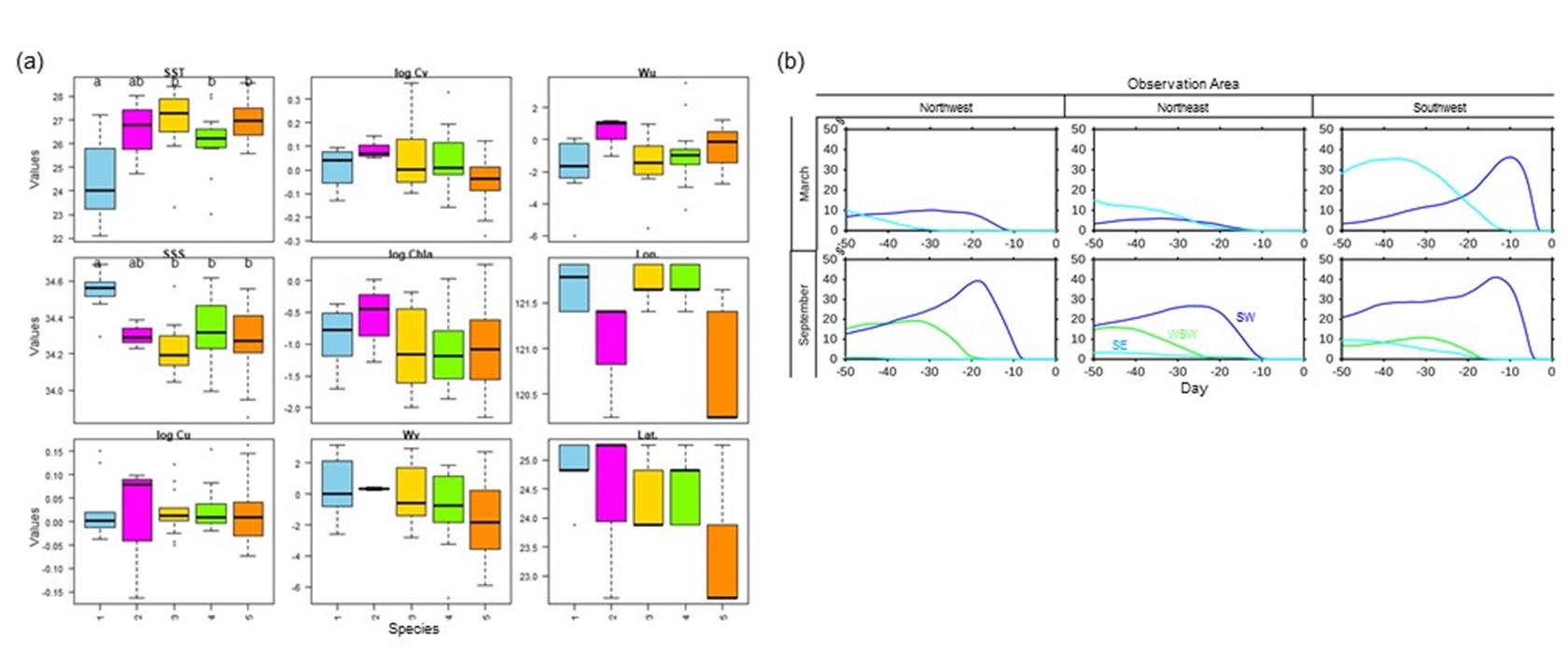多重尺度環境變遷對臺灣沿岸魚類洄游與分布組成研究與應用
Multiscale Environmental Changes for Anchovy Migration and Larval Distributions and Assemblages in the Coastal Waters of Taiwan
計畫主持人:臺大漁科所-柯佳吟、中研院環變中心-辛宜佳
瞭解臺灣沿岸魚類洄游與分布可同時解答生態學與漁業管理學可能受環境變遷之衝擊變化。本計畫利用歷年漁業捕撈資料,首次對鯷科與鯡科魚類空間分布以及組成進行區域性評估,並以漁業捕撈之目標區分目標與混獲魚種後,剖析物種間豐度變動關係,最後結合航行軌跡追蹤記錄,回推捕撈區域以作為物種分布之觀測,透過溯源追踪模擬推測成魚產卵與繁殖區域所在。研究結果顯示,年度變化表明相異地點的貢獻度,而月變化表明相異季節的魚類多樣性;當將臺灣海域區分為數個區域時,可以發現區域和環境因子都會對魚類組成產生影響,尤其是前者;不管是以網次或航次努力量重新分配漁獲並推估魚種分布的方法,雖空間差異小但確實仍存在差異;溯源追踪模擬顯示臺灣海域南方有3 個主要產卵與繁殖區,包含珠江附近、東沙島附近、菲律賓東部海域,不同海域的貢獻度則因季節而異。整體而言,高頻採樣,即每月和每週的漁獲量收集,確實可以提供相當程度魚種分布的訊息,長期的資料累積,則幫助釐清海流和風力影響,當我們更清楚物種產卵和繁殖的時空變動時,除可作為保育管理的基礎資訊,對於了解不同年間的漁業生產將有機會提供經濟產業的相關估算。
圖 1、(a)相異物種對海洋環境偏好情形,粉、綠、藍、橘、黃色分別代表物種為Dussumieria elopsoides、Encrasicholina punctifer、Engraulis japonicas、Encrasicholina heteroloba、mix species。(b)相異區域之物種分布透過向後模擬模式推估其繁殖與產卵區域分布百分比。
SW:西南海域,WSW:西南西海域,SE:東南海域。
Understanding migration and distribution of fishes along the coast of Taiwan can answer questions simultaneously of how ecology and fishery management may be impacted by environmental changes. We conducted the first regional assessment of the spatial distribution and composition of anchovy using decadal fishing records. Relationships between species were analyzed when target and bycatch fish species were distinguished according to fishing goals, and when combining data from voyage data recorder and regarding fishing areas as species distribution areas, backward tracking simulation was finally used for exploring fish breeding and spawning areas. Both net effort- and trip effort-based methods could be used for allocating fish catches and there were few spatial differences observed between two methods. Backward tracking simulation indicated that there would be three source areas, including the vicinity of Pearl River, the vicinity of Dongsha Island, and the east of Philippines, from the south contributing to the anchovy fish surrounding Taiwan. Their contributions varied with season. Overall, high frequency sampling, i.e., monthly and weekly catch collection, can provide more information about fish distributions, and long-term monitoring can help to clarify influence of ocean currents and winds on fish migration and distribution. Better understandings about spatial and temporal dynamics of species breeding and spawning can not only be used as basics for conservation and management, but also provide an opportunity for fisheries economic estimation.
Figure1. (a) Environmental preference among fish species. Pink, green, blue, orange and yellow colors represnet Dussumieria elopsoides, Encrasicholina punctifer, Engraulis
japonicas, Encrasicholina heteroloba, and mix species, respectively. (b) Percentage distributions of possible breeding and spawning areas of species observed from different areas
using backward simulation in March and September. SW:Southwest oceanic area,WSW:West-southwest oceanic area,SE:Southeast oceanic area.

